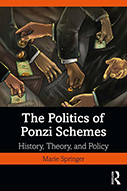The Politics Of Ponzi Schemes: History, Theory, And Policy

Author: Marie Springer
Publisher: Oxon, Abingdon, UK; New York: Routledge, 2020. 338p.
Reviewer: Colleen P. Eren | September 2021
The Bernard Madoff Ponzi scheme, which unraveled in 2008, bilking tens of thousands of investors out of almost 20 billion dollars, brought massive public attention to this type of fraud, particularly since it coincided with a financial crisis and other wide-scale revelations of white-collar crime that had seriously troubled the US economy. Given the Madoff case’s impact, one might have expected criminologists and sociologists to have turned to studying these schemes. While narrowly focused articles have indeed appeared, scholarly books on the subject have been scarce. Most of the latter have been written by journalists for a mass market audience, and are therefore story-driven and anecdotally focused on post-mortems of individual or a series of high-profile cases, such as those of Charles Ponzi himself, Samuel Israel or, most frequently, Bernie Madoff. Colleen Cross’s (2021) Anatomy of Ponzi Scams adopts a case-study approach of the top 10 Ponzi schemes, and does so for a general readership. A few exceptions exist from legal scholars, such as Kathy Phelps and Steven Rhodes’ The Ponzi Book: A Legal Resource for Unraveling Ponzi Schemes; but it is focused on post-fraud litigation. Legal scholar Tamar Frankel’s The Ponzi Scheme Puzzle: A History and Analysis of Con Artists and Victims (2012) moves away from a high-profile case study approach, providing a general scholarly overview of the crime for a lay audience, but still draws on a limited sample of individual stories to reach conclusions about the modus operandi of Ponzi scheme perpetrators and the characteristics of their victims.
Marie Springer’s The Politics of Ponzi Schemes: History, Theory, Policy (2021) provides a much-needed scholarly intervention in this space, giving the most comprehensive academic resource on Ponzi schemes to date; one that is not case-study focused or rooted in a sample of cases, but in fact studies all known Ponzi schemes garnered from federal agency documents for almost 60 years (1962-2020), including 1359 Ponzi schemes. Using this unique dataset which she updates daily utilizing Securities and Exchange Commission, Commodities, Futures Trading Commission, Federal Bureau of Investigation, Internal Revenue Service, and other agency data, Springer has provided what this reviewer considers to be the most comprehensive academic resource on Ponzi schemes to date. From typologies of Ponzi schemes to the economic trends that facilitate them, to using theory to understand the crimes, to the characteristics of both victims and perpetrators, she has provided a veritable encyclopedia about these devastating frauds.
The book is divided into three Parts, with twelve chapters in total. Part I is focused on the Ponzi offenses in the author’s dataset, while Part II discusses the offenders and their victims. Part III presents a smorgasbord of “background” context — historical, economic, and legislative — situating the various schemes and describing trends based on these factors. This section also presents an investor-focused list of red flags and resources from which to ascertain as much as possible the validity of an investment by using public sources. Through all sections, Springer provides ample brief examples of Ponzi schemes that illustrate her point, rather than focusing on a few emblematic ones; an approach which provides a nice contrast to previous scholarship.
Part I, focuses on the Ponzi offenses, laying out the basics of Ponzi scheme terminology, classification, and presenting interesting and helpful typologies. A very valuable contribution to the literature found in this section is Springer’s identifying whether or not the Ponzi schemes were “intentional,” (e.g. started out as Ponzi schemes), or “unintentional,” (coming about as a result typically of a business failure). Her research showed that most Ponzi schemes were, in fact, intentional; only about 10% were unintentional. Here, she also documents the number of affinity-based frauds (e.g. those that were enabled through some kind of shared group membership between perpetrator and victims), and the subcategories therein. A separate chapter lays out a quantitative and qualitative account of the discreet “manners and means” (aka modus operandi) of Ponzi schemes, and whether these were rooted in some fact (for example, were investments in any kind of maiden options, futures, etc.) or were they complete fabrications.
In Part II, Springer describes the 3209 perpetrators (some who acted as individuals and others in groups) and their victims. Demographic data on race, gender, and age are presented, as well as the relationships among those who committed the fraud, in some instances involving brothers, wives, and/or children. She also provides information about the professions (or purported professions) of the perpetrators, which range from the clergy to law enforcement. Springer describes how perpetrators may find their victims through affinity frauds that play on personal feelings of warmth of a particular group of people to members of that same in-group (whether based on religion, nationality, ethnicity, etc.), through professional affiliations, and through institutional investors like unions and pensions. Also presented are data on the sentences of the perpetrators — approximately 60 percent of them were sentenced to an average sentence of 97 months. In most cases the perpetrators received both civil sanctions and criminal convictions.
Springer argues in Part III that with the rise of new technologies or products, Ponzi schemes centered around such advancements will arise. And so, with the rise of Bitcoin and other cryptocurrencies, she says, one may expect to see related schemes soon.
One criticism of the book is with the author’s inferring of motive. In describing the characteristics of the victims and perpetrators, Springer stresses greed as a necessary component (one of five possibilities) facilitating the fraud. Greed is said to be a motivator for both victims and perpetrators. Greed is defined here as an “insatiable, ego-driven need for more money and more possessions,” and, Springer believes that victims should have known at some level something was amiss or was at least suspicious. Given that, as is also described in the book, some victims were brought in through pensions, or through their religious groups, or by the promise of small steady returns, and that fraudsters often play on social bonds of trust in affinity groups, “greed” as such seems much to blunt an explanation of the victims’ motives and levels of awareness/sophistication. In terms of the perpetrators’ motives, she simply concludes that interviews with them lack value because of their chronic deceit.
Overall, I recommend The Politics of Ponzi Schemes highly, as it is an invaluable, rigorously researched, insightful and fascinating analysis. It should be the gold standard among studies of this type of fraud, the first and only to rely on a dataset spanning 60 years rather than just individual case studies. Written without jargon, its most natural audience will be scholars and instructors of white-collar crime, and maybe those who have been immediately impacted by these frauds.
Colleen P. Eren, Associate Professor of Sociology and Criminal Justice, William Paterson University


